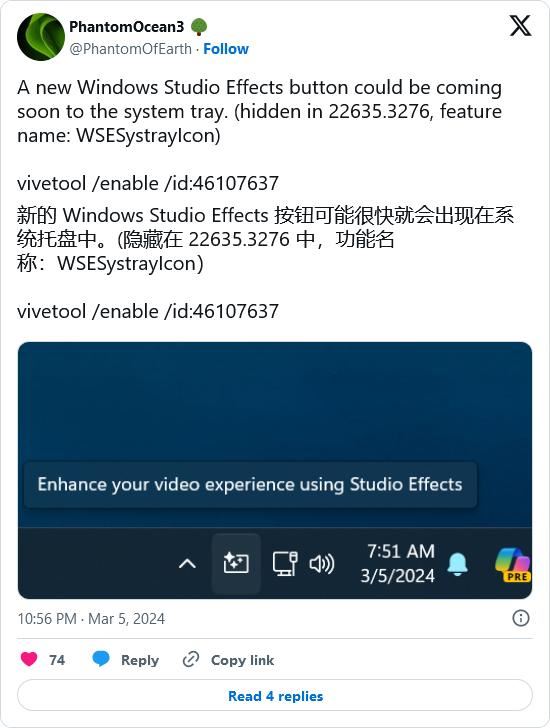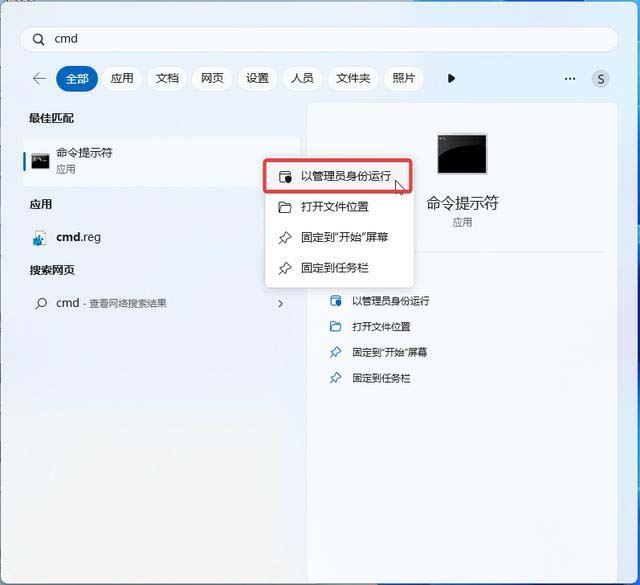 System Tutorial
System Tutorial
 Windows Series
Windows Series
 How to enable the Windows Studio Effects button in the system tray of Win11 preview version 22635.3276?
How to enable the Windows Studio Effects button in the system tray of Win11 preview version 22635.3276?
How to enable the Windows Studio Effects button in the system tray of Win11 preview version 22635.3276?
Apr 11, 2024 pm 08:04 PMphp Editor Apple introduces Win11 preview version 22635.3276 How to enable the Windows Studio Effects button in the system tray? The Win11 preview version has updated the system tray design, adding a Windows Studio Effects button, allowing users to quickly switch system appearance and effects. This is a very useful feature for users who want to try out new features. Next, we’ll detail how to enable the Windows Studio Effects button in the system tray in Windows 11 preview build 22635.3276.

Note: Windows Studio Effects is a video experience enhancement function based on machine learning algorithms. It deploys certain functions for the user's camera and microphone by calling the Neural Processing Unit (NPU). Filters and effects to improve how you look and sound during video calls.
Windows Studio Effects has 4 main uses, 3 for cameras and 1 for microphones:
- Automatic framing: As the name suggests, this feature allows the camera viewfinder to automatically adjust to maintain focus.
- Background Effect (Blur): This feature allows you to blur background elements in the camera view. You can choose a standard blur or a softer portrait blur.
- Eye Contact: When you look at the screen, this camera effect compensates to make it appear as if you are making eye contact with the other person on the call.
- Voice Focus: This microphone effect filters out background noise to ensure your voice is clear and audible.
Users can now use the third-party tool ViVeTool to display it in the system tray in Windows 11 Build 22635.3276 preview.
Netizens can enable the above new functions and features through the ViveTool tool:
1. Download the Vivetool tool from the GitHub page, and then unzip it to any folder, but you need to remember the folder Path (for example, C:\Program Files (x86)\ViVeTool-v0.3.2)
2. Press the Win key (or use the mouse) to open the start menu, enter "cmd", and then select "As Administrator" Permissions" to open the command prompt

3. Use the cd command to jump to the ViveTool folder, for example "cd C:\Program Files (x86)\ViVeTool-v0.3.2 ”

4. Then enter vivetool /enable /id:46107637 and press Enter
5. Restart computer
The above is the detailed content of How to enable the Windows Studio Effects button in the system tray of Win11 preview version 22635.3276?. For more information, please follow other related articles on the PHP Chinese website!

Hot AI Tools

Undress AI Tool
Undress images for free

Undresser.AI Undress
AI-powered app for creating realistic nude photos

AI Clothes Remover
Online AI tool for removing clothes from photos.

Clothoff.io
AI clothes remover

Video Face Swap
Swap faces in any video effortlessly with our completely free AI face swap tool!

Hot Article

Hot Tools

Notepad++7.3.1
Easy-to-use and free code editor

SublimeText3 Chinese version
Chinese version, very easy to use

Zend Studio 13.0.1
Powerful PHP integrated development environment

Dreamweaver CS6
Visual web development tools

SublimeText3 Mac version
God-level code editing software (SublimeText3)

Hot Topics
 How do I view the commit history of my Git repository?
Jul 13, 2025 am 12:07 AM
How do I view the commit history of my Git repository?
Jul 13, 2025 am 12:07 AM
To view Git commit history, use the gitlog command. 1. The basic usage is gitlog, which can display the submission hash, author, date and submission information; 2. Use gitlog--oneline to obtain a concise view; 3. Filter by author or submission information through --author and --grep; 4. Add -p to view code changes, --stat to view change statistics; 5. Use --graph and --all to view branch history, or use visualization tools such as GitKraken and VSCode.
 How do I delete a Git branch?
Jul 13, 2025 am 12:02 AM
How do I delete a Git branch?
Jul 13, 2025 am 12:02 AM
To delete a Git branch, first make sure it has been merged or no retention is required. Use gitbranch-d to delete the local merged branch. If you need to force delete unmerged branches, use the -D parameter. Remote branch deletion uses the gitpushorigin-deletebranch-name command, and can synchronize other people's local repositories through gitfetch-prune. 1. To delete the local branch, you need to confirm whether it has been merged; 2. To delete the remote branch, you need to use the --delete parameter; 3. After deletion, you should verify whether the branch is successfully removed; 4. Communicate with the team to avoid accidentally deleting shared branches; 5. Clean useless branches regularly to keep the warehouse clean.
 Can I buy Dogecoin in the currency circle? How to identify scam items?
Jul 10, 2025 pm 09:54 PM
Can I buy Dogecoin in the currency circle? How to identify scam items?
Jul 10, 2025 pm 09:54 PM
The "Dogcoin" in the currency circle usually refers to newly issued cryptocurrencies with extremely low market value, opaque project information, weak technical foundation or even no practical application scenarios. These tokens often appear with high-risk narratives.
 How to identify fake altcoins? Teach you to avoid cryptocurrency fraud
Jul 15, 2025 pm 10:36 PM
How to identify fake altcoins? Teach you to avoid cryptocurrency fraud
Jul 15, 2025 pm 10:36 PM
To identify fake altcoins, you need to start from six aspects. 1. Check and verify the background of the materials and project, including white papers, official websites, code open source addresses and team transparency; 2. Observe the online platform and give priority to mainstream exchanges; 3. Beware of high returns and people-pulling modes to avoid fund traps; 4. Analyze the contract code and token mechanism to check whether there are malicious functions; 5. Review community and media operations to identify false popularity; 6. Follow practical anti-fraud suggestions, such as not believing in recommendations or using professional wallets. The above steps can effectively avoid scams and protect asset security.
 Completed python blockbuster online viewing entrance python free finished website collection
Jul 23, 2025 pm 12:36 PM
Completed python blockbuster online viewing entrance python free finished website collection
Jul 23, 2025 pm 12:36 PM
This article has selected several top Python "finished" project websites and high-level "blockbuster" learning resource portals for you. Whether you are looking for development inspiration, observing and learning master-level source code, or systematically improving your practical capabilities, these platforms are not to be missed and can help you grow into a Python master quickly.
 What is AMA in the currency circle? How to judge the authenticity of the project?
Jul 11, 2025 pm 08:39 PM
What is AMA in the currency circle? How to judge the authenticity of the project?
Jul 11, 2025 pm 08:39 PM
AMA in the currency circle is the abbreviation of Ask Me Anything, which is literally translated as "ask me any questions". This is a form of interaction between project parties and community members. Project teams usually broadcast live on specific platforms, such as Telegram groups, Discord servers, or via Twitter Spaces, to open questions to participants. Community members can take this opportunity to directly raise questions about any aspects such as technology, economic model, marketing promotion, roadmap, etc. to the core members of the project.
 What is the code number of Bitcoin? What style of code is Bitcoin?
Jul 22, 2025 pm 09:51 PM
What is the code number of Bitcoin? What style of code is Bitcoin?
Jul 22, 2025 pm 09:51 PM
As a pioneer in the digital world, Bitcoin’s unique code name and underlying technology have always been the focus of people’s attention. Its standard code is BTC, also known as XBT on certain platforms that meet international standards. From a technical point of view, Bitcoin is not a single code style, but a huge and sophisticated open source software project. Its core code is mainly written in C and incorporates cryptography, distributed systems and economics principles, so that anyone can view, review and contribute its code.
 How do I add a subtree to my Git repository?
Jul 16, 2025 am 01:48 AM
How do I add a subtree to my Git repository?
Jul 16, 2025 am 01:48 AM
To add a subtree to a Git repository, first add the remote repository and get its history, then merge it into a subdirectory using the gitmerge and gitread-tree commands. The steps are as follows: 1. Use the gitremoteadd-f command to add a remote repository; 2. Run gitmerge-srecursive-no-commit to get branch content; 3. Use gitread-tree--prefix= to specify the directory to merge the project as a subtree; 4. Submit changes to complete the addition; 5. When updating, gitfetch first and repeat the merging and steps to submit the update. This method keeps the external project history complete and easy to maintain.





